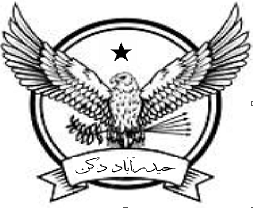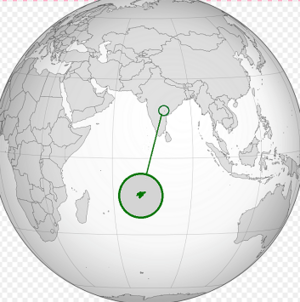Hyderabad Deccan
Hyderabad Deccan (Urdu: حیدرآباد دکن), officially the Islamic State of Hyderabad Deccan (Urdu: اسلامی جمہوریہ حیدرآباد دکن) is the fifth smallest country in the world, at only 46km2 (29 sq mi) and a South Asian microstate enclaved by the Telugu People's Republic. Hyderabad Deccan is located in the southern part of the Golconda-Hyderabad metropolitan area, and has a population of 542,000.
Formerly, Hyderabad Deccan was the location of the historic capital of the Hyderabad State under the British paramountcy then a Princely State of India until the independence of the British dominions in South Asia in 1947. Following the Telangana Uprising and Subsequent Revolution, Hyderabad Deccan was established as a Muslim majority state as opposed to the Telugu People's Republic which is majority Hindu and primarily Telugu speaking. This was agreed in 1950 and is known as the Musi Agreement.
Islamic State of Hyderabad Deccan اسلامی جمہوریہ حیدرآباد دکن
Islāmī Jumhūriyah Haiderābād Dekhan | |
|---|---|
| Motto: "خدا کے نیچے وطن" (Urdu) "Homeland under God" | |
| [[
[[ |thumb]] |thumb|right|220px]] | |
| Capital | Hyderabad |
| Official languages | |
| Recognised languages | |
| Ethnic groups | |
| Demonym(s) | Hyderabad Deccani, Mulkhi |
| Government | Republic |
| Syed Bakhash Muhammad | |
• Nizam | Mukarram Jah, Asaf Jah VIII |
| Legislature | National Council |
| Formation | |
• Independence from the UK (As Hyderabad State) | 15 August 1947 |
• Telangana Uprising | 1 October 1947 |
• Musi Agreement | 4 October 1950 |
| Area | |
• Total | 46 km2 (18 sq mi) (192nd) |
• Water (%) | 4 |
| Population | |
• July 2021 estimate | 542,000 (168th) |
• 2020 census | 540,000 |
• Density | 11,782/km2 (30,515.2/sq mi) (3rd) |
| GDP (PPP) | 2017 estimate |
• Total | $9.24 billion |
• Per capita | $17,052 (90th) |
| Gini (2018) | medium (91st) |
| HDI | high (76th) |
| Currency | Hyderabadi Rupee, Telugu Rupee (₹) (DCR) |
| Time zone | UTC+5:30 (IST) |
• Summer (DST) | UTC+5:30 (not observed) |
| Driving side | left |
| Calling code | +94 |
| Internet TLD | .hd |
Etymology
The name 'Hyderabad' means 'Haydar's City' or "lion city", from haydar 'lion' and ābād 'city', after Caliph Ali Ibn Abi Talib, also known as Haydar because of his lion-like valour in battle.
'Deccan' refers to the Deccani People, who are an ethnoreligious community of Urdu-speaking Muslims inhabiting the Deccan region of Southern and Central South Asia. Hyderabad Deccan's citizens are mostly Deccani and the nation is a cultural centre for Deccanis, who are a minority group in India and the TPR. The word Deccani (Persian: دکنی from Prakrit dakkhin "south") was derived in the court of Bahmani rulers in 1487 AD during Sultan Mahmood Shah Bahmani II.
History
Early and Medieval History
There is evidence that the area around Hyderabad Deccan has been inhabited since as early as the Stone Age. Archaeologists excavating near the city have unearthed Iron Age sites that may date from 500 BCE. The region comprising modern Hyderabad Deccan and its surroundings was ruled by the Chalukya dynasty from 624 CE to 1075 CE. Following the dissolution of the Chalukya empire into four parts in the 11th century, Golconda (which included Hyderabad Deccan) came under the control of the Kakatiya dynasty from 1158. Following this in 1325, the area of Hyderabad Deccan was brought under the Tughluq Dynasty of the Delhi Sultanate. In 1347, the Bahmani Sultanate was established in the region, which ruled until 1518 and were the first independent Muslim rulers of the Deccan.
In 1518, Sultan Quli, who had Turkoman origin, revolted against the Bahmani Sultanate and established the Qutb Shahi dynasty of the Golconda Sultinate. The sultanate was notiriously wealthy, with a monopoly on diamond production from mines in the southern districts of the kingdom. The fifth Qutb Shahi sultan, Muhammad Quli Qutb Shah, established Hyderabad as a capital city on the banks of the Musi River in 1591. During his rule, he had the Charminar and Mecca Masjid built in the city. Mir Momin Astarabadi, the prime minister in the Qutb Shahi period, developed the plan of the city of Hyderabad, including the location of the Charminar and Char Kaman.
Modern and Colonial History
On 21 September 1687, the Qutb Shahi Dynasty came under the rule of the Mughal emperor Aurangzeb. The annexed city of Hyderabad was renamed Darul Jihad (House of War), whereas its state 'Golconda' was renamed Deccan Suba (Deccan province). In 1713, Mughal emperor Farrukhsiyar appointed Mubariz Khan as Governor of Hyderabad. During his tenure, he fortified the city and controlled the internal and neighbouring threats. In 1714 Farrukhsiyar appointed Asaf Jah I as Viceroy of the Deccan with the title Nizam-ul-Mulk (Administrator of the Realm) and subsequently in 1721, he was appointed as Prime Minister of the Mughal Empire.
Asaf Jah I established autonomy over the Deccan, named the region Hyderabad Deccan, and started what came to be known as the Asaf Jahi dynasty. Subsequent rulers retained the title Nizam ul-Mulk and were referred to as Asaf Jahi Nizams, or Nizams of Hyderabad. The death of Asaf Jah I in 1748 resulted in a period of political unrest as his sons and grandson contended for the throne backed by opportunistic neighbouring states and colonial foreign forces. The accession of Asaf Jah II, who reigned from 1762 to 1803, ended the instability. In 1768 he signed the Treaty of Masulipatam—by which the East India Company in return for a fixed annual rent, got the right to control and collect taxes.
In 1769 Hyderabad city became the formal capital of the Asaf Jahi Nizams. In response to regular threats from outside forces, the Nizam signed a subsidiary alliance with the East India Company in 1798, allowing the British Indian Army to be stationed at Bolarum (modern Secunderabad) to protect the state's capital, for which the Nizams paid an annual maintenance to the British. When the English East India Company achieved paramountcy over the Indian subcontinent, they allowed the Nizams to continue to retain internal power over Hyderabad State. Maintenance of British forces, which was part of subsidiary alliance with British, put heavy burden on Hyderabad state and bankrupted it in the early 19th century.
5 more Nizams ruled Hyderabad State under the British paramountcy. Asaf Jah V's reign was marked by reforms by his Prime Minister Salar Jung I, including Hyderabad revenue and judicial systems, a postal service and constructed the first rail and telegraph networks. The first higher educational institution of Hyderabad known as Dar-ul-Uloom was established during his reign. The Nizam's Guaranteed State Railway was established in 1879, a railway company fully owned by the Nizam. The Great Musi Flood of 1908 ravaged Hyderabad, killing an estimated 15,000 people and affecting at least 200,000. The 7th Nazam, Mir Osman Ali Khan, was the world's richest man in the 1930s.
Independence
In 1947 India gained independence and Pakistan came into existence. The British left the local rulers of the princely states the choice of whether to join one or the other, or to remain independent. On 11 June 1947, the Nizam issued a declaration to the effect that he had decided not to participate in the Constituent Assembly of either Pakistan or India, and declared Hyderabad a free, self-governing independent state. The princely states of Madras, Mysore, Travancore and Cochin (which later united to form Kerala) were also declared independent states. These newly independent nations signed the Kolar defence agreement, which aimed to preserve the independence of the southern nations against aggression from India, which had threatened to invade territories in Hyderabad and Mysore.
Within months of Hyderabad's independence, the Telangana Uprising began, escalating out of agitations in 1944-46. Hyderabad State was a feudal monarchy where most of the land was concentrated in the hands of landed aristocrats known as Doras, and the rebels sought to abolish this system and instate a communist regime of government. Furthermore, Hyderabad State had been controlled by an elite upper class of Urdu-speaking Muslims, who constituted a minority of the State's population and the Telangana Uprising also aimed to establish a Hindu controlled nation in the area to reflect this. Despite efforts by the 7th Nizam Osman Ali Khan to quell the rebellion, the communist party grew in power, controlling much of rural Hyderabad State. Conflict in the nation continued for over 6 months, with the communist rebels being supported by communist insurgents in Madras, which had also become independent in 1947. By early 1948, much of Hyderabad State was beginning to rebel in an all-out revolution as more of the rural poor and the peasantry organised themselves under the communists and took up arms against the Doras and the Hyderabad government.
Requests by the Nizam for military support from the British government were denied and despite having suffered substantially less casualties, the government was struggling to maintain control of Hyderabad State. When the conflict had just passed its 1-year mark, the Soviet Union and Kerala (which also had a communist government) began to supply arms to the communists. This allowed the rebels to gain more military strength in the state. After another 2 years of fighting, the two sides began negotiating a settlement to end the conflict, which culminated in the Musi agreement. According to the agreement, the much weakened Hyderabad State government would be able to maintain an Urdu speaking Muslim majority nation in the historically Muslim area of the old city of Hyderabad. The remainder of Hyderabad State would become a primarily Telugu speaking, Hindu majority, communist state. This led to the establishment of Hyderabad Deccan and the Telugu People's Republic.
Post Independence
Much of Hyderabad Deccan had to be rebuilt after the violence of the Telangana revolution, and the power and wealth of the Nizam was significantly damaged. Despite tensions between the Hyderabad Deccani and Telugu governments, practical border arrangements were introduced in 1951 with the movement of peoples act. This allowed Hyderabad Deccani people to move through the TPR without significant border controls.
Under the 8th Nizam Mukarram Jah in the 1970s and 80s, significant democratising reforms were made to Hyderabad Deccan's political system, which included the establishment of the National Council, replacing the Executive Council, which was a more deliberative chamber. Telugu also became a recognised language of Hyderabad Deccan, reflecting the 10% of the population who were ethnically Telugu and the significant proportion of the Hyderabad Deccani population who spoke Telugu as a second language.
In recent decades, Hyderabad Deccan has become a hub for technology companies such as Amazon, Microsoft and HCL.


